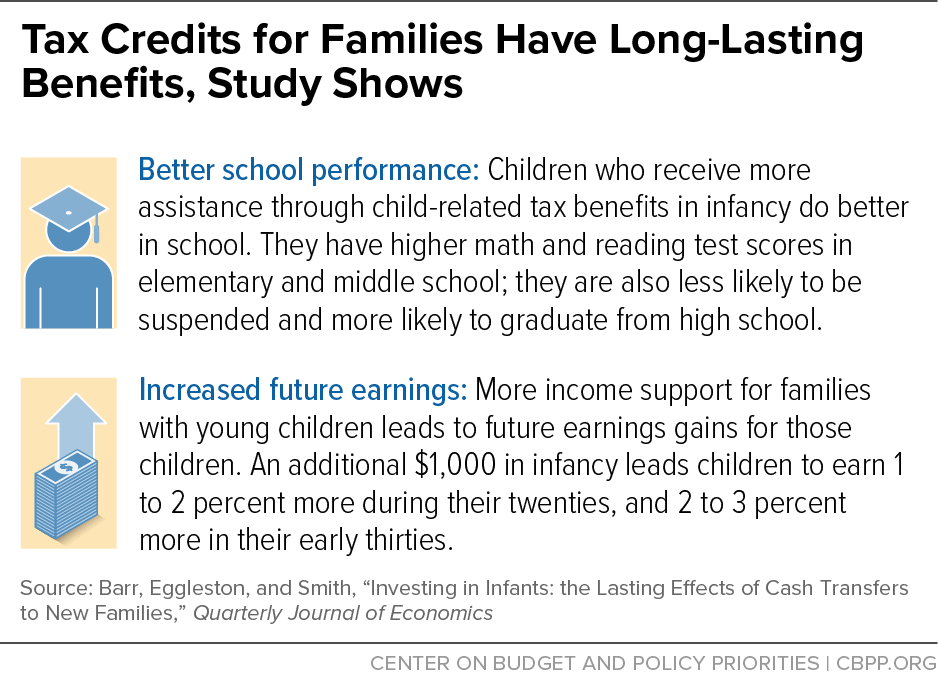BEYOND THE NUMBERS
A new study shows that cash assistance for low-income households with infants can have “profound and long-lasting effects” on children’s well-being. The study, “Investing in Infants: the Lasting Effects of Cash Transfers to New Families,” finds that infants in families who receive more support from child-related tax benefits go on to have higher test scores, high school graduation rates, and earnings into young adulthood. The benefits came primarily from the Earned Income Tax Credit (EITC), and to a lesser extent, a dependent exemption that reduced taxable income for families with children. This evidence strengthens the case that Congress should expand the Child Tax Credit to establish a foundation of economic security for children.
The new research is important for three main reasons.
First, it is carefully conducted. Authors Andrew Barr, Jonathan Eggleston, and Alexander A. Smith demonstrate a causal link between aid to families with young children from child-related tax benefits (primarily the EITC) and improved outcomes for children later in life. The study, in the Quarterly Journal of Economics, uses tax benefit eligibility rules to compare otherwise similar children born just before or after January 1. (Children born just before the new year are eligible for one more year of benefits in early childhood than those born just after the new year.) Further increasing our confidence that the findings are relevant for policy today, the study tracks recent cohorts of children into their twenties and thirties using large samples of administrative records, which are often more reliable than survey data.
Second, while many studies explore the ways society benefits from bolstering the incomes of families with children, this is one of the few to track children far enough into their adult years to calculate the earnings gains resulting from childhood income support. Economists Anna Aizer, Hilary Hoynes, and Adriana Lleras-Muney contend in a recent paper that economists fixated for too long on the potential negative consequences of means-tested assistance among adults, but that when “the positive long-run benefits to children are considered, many safety net programs are cost-effective.” Barr and his co-authors find that is true of the EITC. They show that an additional $1,000 in infancy leads children to earn 1 to 2 percent more during their twenties, and 2 to 3 percent more in their early thirties; this puts cash aid to families with low income in a class of high-return investments (these include support for kids’ education and health care) documented by previous researchers.
Third, the new research offers insight into how income assistance in early childhood helps children thrive later in life. It finds that support for families with young children through the EITC leads to stronger academic performance among the children, which in turn appears to account for their higher earnings when they reach their twenties and thirties. Based on prior literature, the authors also note that even temporary aid to low-income families can help them avoid “short-term stress with long-term ramifications” from adverse events such as eviction, food insecurity, or loss of transportation. This could explain how a more financially secure environment helps children in school.
As with any single study, the new paper has limitations, so applying the findings to different contexts requires care. For instance, it focuses on how a few thousand dollars affects new families (that is, families after first births) and does not address either differently sized or longer-lasting investments or how income support impacts older children. “With those caveats, our results do suggest that additional resource transfers to poor families around the time of a first birth would result in substantial improvements in social mobility,” the authors note.
In 2021, the expanded Child Tax Credit in the American Rescue Plan delivered more resources to families with the lowest incomes, especially those with young kids, for whom the credit was largest. The enhanced credit also included monthly payments, and the Federal Reserve’s report on the economic well-being of households in 2021 found “most lower-income parents primarily spent it on housing, items for their children, or food.” Lawmakers allowed the expansion to expire, which left millions more parents and children in poverty. The study by Barr and his co-authors suggests that this will impede the academic and economic progress of children in families with low incomes for decades.
One nuance in drawing lessons about the expanded Child Tax Credit from EITC research is that the EITC benefits only families who are working in a given year, whereas the expanded Child Tax Credit allowed children in families with low or no income in 2021 to receive the full credit (sometimes called “full refundability”). While the new study examines the EITC, it builds on research that finds future income gains for children who benefited from the Supplemental Nutrition Assistance Program (formerly known as food stamps), which does not require parents to have earnings. Together, these findings demonstrate the importance of adequate resources for young children, including in families with the lowest incomes. Some critics nonetheless argue that because the expanded Child Tax Credit benefits a broader population and could discourage people from working, it should be evaluated separately from the EITC.
While questions about employment are legitimate, they should be understood in the proper context — most families affected by full refundability work and would continue to do so under an expanded Child Tax Credit. In over 95 percent of families who benefit from the full Child Tax Credit being available to all households, the parent or other caretaker is working, between jobs, ill or disabled, elderly, or has a child under age 2. And estimates of the share of parents who would continue to work under the expanded credit range from over 97 percent to over 99 percent.
Aizer, Hoynes, and Lleras-Muney explain that the potential for negative behavioral impacts among adults, “even if small,” have received outsized attention. “A new focus on the benefits of safety net programs on children — the intended beneficiaries of these programs — that incorporates evidence on their many long-term benefits” will contribute to better public policy, they conclude. The new study adds to mounting evidence that the benefits from policies that provide economic security to children are significant and long-lasting.
Congress should act now to expand the Child Tax Credit, and most importantly, make the full credit available to children in families with the lowest incomes.

